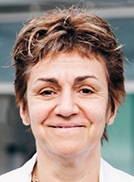Axicabtagene ciloleucel demonstrates superiority over second-line standard of care in patients ≥ 65 years with R/R LBCL
At EHA 2022, Prof. Sureda reported the results of a planned subgroup analysis of the ZUMA-7 study assessing outcomes, including patient-reported outcomes, of second-line axicabtagene ciloleucel (axi-cel) versus standard of care (SOC) in elderly patients with relapsed/refractory large B-cell lymphoma. Axi-cel demonstrated superiority over second-line SOC in patients ≥ 65 years with significantly improved event-free survival, a manageable safety profile and meaningful improvement in quality of life.
Axicabtagene ciloleucel (axi-cel) is an autologous anti-CD19 CAR T-cell therapy approved for the treatment of adult patients with relapsed or refractory large B-cell lymphoma (R/R LBCL) after at least two lines of systemic therapy. The median age at LBCL diagnosis is 66 years, and age can be a determining factor in the decision to use curative therapy. Moreover, older patients with R/R LBCL are at increased risk of inferior outcomes, increased toxicity and inability to tolerate second-line standard of care (SOC) treatment. In addition, second-line treatment is often associated with poor health-related quality of life (HRQoL). ZUMA-7 is the first randomised, global, multicentre, phase III study of axi-cel versus SOC as second-line treatment in patients with R/R LBCL. At EHA 2022, Prof. Sureda presented the safety, efficacy and patient-reported outcome (PRO) results in a pre-planned subgroup analysis of ZUMA-7 patients aged ≥ 65 years.
Study design
Patients with an ECOG performance status 0-1 and R/R LBCL ≤ 12 months after first-line chemo-immunotherapy (CIT) were randomised (1:1) to axi-cel or SOC (2-3 cycles of platinum-based CIT; patients with partial or complete response [CR] proceeded to high-dose therapy with autologous stem cell transplantation [HDT-ASCT]). PRO instruments, including the EORTC QLQ-C30 (Global Health and Physical Functioning) and the EQ-5D-5L visual analogue scale (VAS), were administered at baseline (prior to treatment), day 50, day 100, day 150, and month 9, then every 3 months up to 24 months or time of event-free survival (EFS), whichever occurred first. The quality-of-life analysis set included all patients who had a baseline PRO and ≥ 1 completed measure at day 50, 100, or 150. A clinically meaningful change was defined as 10 points for each EORTC QLQ-C30 score and 7 points for EQ-5D-5L VAS score.
Results
In total, 109 patients of at least 65 years old were enrolled in ZUMA-7, 51 in the axi-cel arm and 58 in the SOC arm. Interestingly, while 49/51 patients (96%) received axi-cel, only 20/58 patients (34%) received HDT-ASCT. As compared to SOC patients, more axi-cel patients had high-risk features at baseline, including second-line age-adjusted International Prognostic Index 2-3 (53% vs. 31%) and elevated lactate dehydrogenase (61% vs. 41%). Furthermore, the axi-cel arm was enriched in patients with high-grade B-cell lymphoma with or without MYC and BCL2 and/or BCL6 rearrangement (33% vs. 14%).
After a median follow-up of 24.3 months, the median event-free survival per blinded central review in patients aged ≥ 65 years was 21.5 months for axi-cel, as compared to only 2.5 months for SOC, with 24-months EFS rates of 47.8% and 15.1%, respectively (HR[95%CI]: 0.276[0.164-0.465], p< 0.0001). The objective response rate was higher with axi-cel versus SOC (88% vs. 52%, descriptive p< 0.0001) and the CR rate of the axi-cel arm was more than double that of the SOC arm (75% vs. 33%, respectively). Overall survival was prolonged in the axi-cel arm compared with SOC (HR[95%CI]: 0.517[0.277-0.964], descriptive p= 0.0175). The Kaplan-Meier estimate of OS at two years was 64% in the axi-cel arm and 51% in the SOC arm. In total, 57% of SOC patients received subsequent cellular immunotherapy (off protocol).
The safety profile of axi-cel was manageable and consistent with previous studies in refractory LBCL. Any grade ≥ 3 adverse events (AEs) were seen in 94% of patients in the axi-cel arm and 82% of patients in the SOC arm, of which pyrexia, neutropenia and nausea were the most frequently reported. The most frequent reason for death was progressive disease in both groups. There were slightly higher rates of cytokine release syndrome and neurologic events, including grade ≥ 3, in patients aged ≥ 65 years as compared with the overall ZUMA-7 population.
In the QoL analysis set comprising 46 axi-cel and 42 SOC patients, there was a clinically meaningful difference in mean change of scores from baseline at day 100 in favour of axi-cel for EORTC QLQ-C30 Global Health (descriptive p< 0.0001), physical functioning (descriptive p= 0.0019) and EQ-5D-5L VAS (descriptive p< 0.0001). For all three domains, scores favoured axi-cel over SOC at day 150 (descriptive p< 0.05).
Conclusion
Axi-cel demonstrated superiority over second-line SOC in patients ≥ 65 years, despite the greater frequency of high-risk features in the axi-cel arm. In addition, axi-cel has a manageable safety profile that was consistent with previous studies and real-world data in patients of all ages. Compared with SOC, axi-cel also demonstrated meaningful improvement in QoL, which suggested faster recovery to pre-treatment QoL. These data demonstrate that older patients, who are frequently considered transplant-ineligible based on age, can safely receive second-line curative intent therapy.
Reference
Sureda A, et al. Clinical and patient-reported outcomes in a phase 3 study of axicabtagene ciloleucel (axi-cel) vs standard-of-care in elderly patients with relapsed/refractory large B-cell lymphoma (ZUMA-7). Presented at EHA 2022; Abstract S211.

